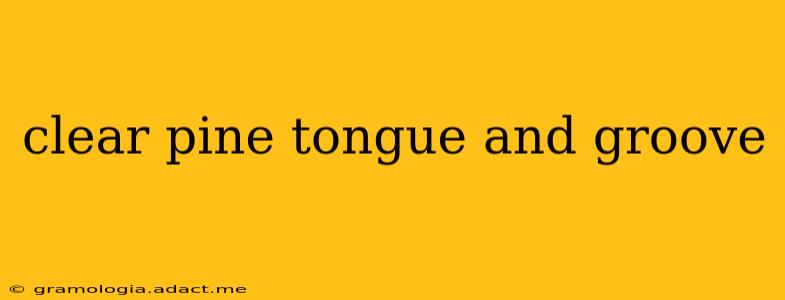Clear pine tongue and groove flooring and paneling offers a classic, timeless aesthetic with a versatile range of applications. Its natural beauty, coupled with its durability and relative affordability, makes it a popular choice for both residential and commercial projects. This comprehensive guide will explore everything you need to know about clear pine tongue and groove, from its characteristics and applications to installation and maintenance.
What is Clear Pine Tongue and Groove?
Clear pine tongue and groove refers to lumber milled with a tongue (a projection) on one edge and a groove (a corresponding recess) on the other. This interlocking design creates a tight, stable fit when boards are joined together, minimizing gaps and creating a seamless surface. The "clear" designation indicates that the wood is graded for minimal knots and imperfections, resulting in a cleaner, more uniform appearance. This contrasts with other grades of pine, which may contain more knots and variations in color.
What are the Advantages of Using Clear Pine Tongue and Groove?
-
Aesthetic Appeal: The clean lines and natural beauty of clear pine create a warm, inviting atmosphere. Its versatility allows it to complement various design styles, from rustic to modern.
-
Durability: Pine is a relatively strong and durable wood, especially when properly finished. Clear pine tongue and groove, with its interlocking design, provides enhanced stability and resistance to warping or shrinking.
-
Affordability: Compared to other hardwood options, clear pine is generally more affordable, making it a cost-effective choice for larger projects.
-
Easy Installation: The tongue and groove system simplifies installation, allowing for a quick and efficient process, even for DIY enthusiasts.
-
Versatility: Clear pine tongue and groove can be used for flooring, wall paneling, ceiling applications, and even crafting projects.
What are the Different Grades of Clear Pine Tongue and Groove?
While the term "clear" suggests a high degree of imperfection-free wood, slight variations can still exist. Lumberyards often categorize clear pine tongue and groove into different grades based on the number and size of knots and other imperfections. Understanding these grades helps in selecting the appropriate material for your specific project. Check with your supplier for precise grading standards as they can vary regionally.
How is Clear Pine Tongue and Groove Installed?
Installation typically involves using construction adhesive and fasteners to secure the boards to the subfloor or framing. The interlocking tongue and groove system ensures a tight, seamless fit between boards. Proper acclimation of the wood to the ambient humidity is crucial to prevent warping or shrinking after installation. Professional installation is recommended for large or complex projects to ensure optimal results.
What are the Maintenance Requirements for Clear Pine Tongue and Groove?
Regular cleaning with a broom or vacuum cleaner will keep the surface free of dust and debris. Periodic cleaning with a damp mop (avoiding excessive water) is also recommended. Depending on the finish, you may need to reapply sealant or finish every few years to maintain the wood’s protection and beauty.
What are Common Uses for Clear Pine Tongue and Groove?
-
Flooring: Creates a warm and inviting atmosphere in residential spaces.
-
Wall Paneling: Adds texture and visual interest to interior walls, offering a classic and timeless design element.
-
Ceiling Applications: Can be used to create a coffered ceiling or to add a rustic touch to a room's overhead space.
How Much Does Clear Pine Tongue and Groove Cost?
The cost varies depending on factors such as the grade of lumber, the thickness of the boards, and the region. It's best to contact local lumber suppliers for up-to-date pricing in your area.
What is the Difference Between Clear Pine and Knotty Pine Tongue and Groove?
The primary difference lies in the wood grading. "Clear" pine has minimal knots and imperfections, while "knotty" pine intentionally retains knots, adding a rustic charm. The choice depends on the desired aesthetic.
Is Clear Pine Tongue and Groove Suitable for Exterior Use?
While clear pine is durable, it's not typically recommended for exterior applications without proper treatment and protection from the elements. Exterior-grade treated lumber is a better choice for outdoor projects.
This comprehensive guide provides a solid foundation for understanding clear pine tongue and groove. Remember to always consult with professionals for large-scale projects or if you have any specific questions or concerns about your project's unique requirements.
